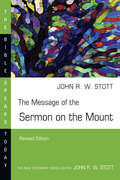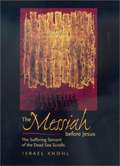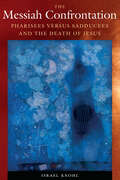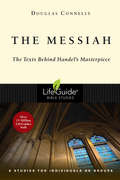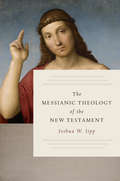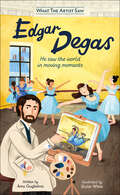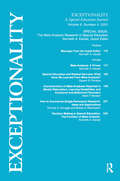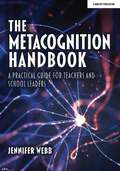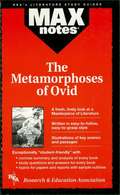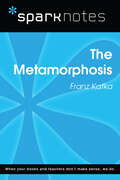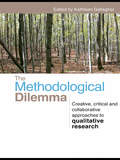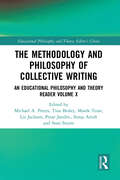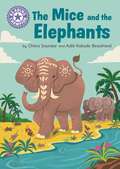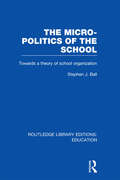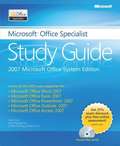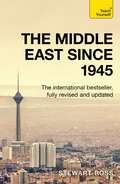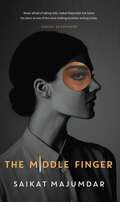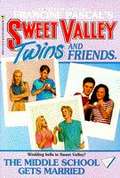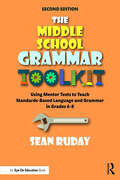- Table View
- List View
The Message of the Sermon on the Mount: Christian Counter-culture (The Bible Speaks Today Series)
by John Stott"The followers of Jesus are to be different," writes John Stott, "different from both the nominal church and the secular world, different from both the religious and the irreligious. The Sermon on the Mount is the most complete delineation anywhere in the New Testament of the Christian counter-culture."
The Messiah Before Jesus: The Suffering Servant of the Dead Sea Scrolls
by Israel Knohl David MaiselOn the basis of hymns found among the Dead Sea Scrolls, Knoll argues that one generation before Jesus, a messianic leader arose in the Qumran sect who was regarded by his followers as ushering in an area of redemption and forgiveness. He was killed by Roman soldiers in 4 B.C.E., and his followers believed he was resurrected after three days and rose to heaven.
The Messiah Confrontation: Pharisees versus Sadducees and the Death of Jesus
by Dr. Israel KnohlThe Messiah Confrontation casts new and fascinating light on why Jesus was killed. Grounded in meticulous research on the messianism debates in the Bible and during the Second Temple period, biblical scholar Israel Knohl argues that Jesus&’s trial was in reality a dramatic clash between two Jewish groups holding opposing ideologies of messianism and anti-messianism, with both ideologies running through the Bible. The Pharisees (forefathers of the rabbinic sages) and most of the Jewish people had a conception of a Messiah similar to Jesus: like the prophets and most psalmists, they expected the arrival of a godlike Messiah. However, the judges who sentenced Jesus to death were Sadducees, who were fighting with the Pharisees largely because they repudiated the Messiah idea. Thus, the trial of Jesus was not a clash between Jewish and what would become Christian doctrines but a confrontation between two internal Jewish positions—expecting a Messiah or rejecting the Messiah idea—in which Jesus and the Pharisees were actually on the same side. Knohl contends that had the assigned judges been Pharisees rather than Sadducees, Jesus would not have been convicted and crucified. The Pharisees&’ disagreement with Jesus was solely over whether Jesus was the Messiah—but historically, for Jews, arguing about who was or wasn&’t the Messiah was not uncommon.The Messiah Confrontation has far-reaching consequences for the relationship between Christians and Jews.
The Messiah: The Texts Behind Handel's Masterpiece (LifeGuide Bible Studies)
by Douglas ConnellyProphets prophesied about him. Angels and shepherds rejoiced at his birth. Friends cried for joy at his resurrection. And we still celebrate him today. He is Jesus, the Messiah. Perfect for Advent or Lent, this eight-session LifeGuide Bible Study guide explores some of the key passages in the Old Testament about the Messiah and their completion in the life and saving work of Jesus. These passages have had a profound effect on the imagination and worship of Christians for two thousand years, leading George Frederic Handel to write one of the greatest expressions of worship and adoration—his oratorio, the Messiah. We hear parts of it sung every year during the Christmas season, but what many listeners fail to realize is that the entire text of Handel's Messiah is drawn from Scripture—and many of the Old Testament passages that shaped Israel's hope for their Redeemer are included in that text. This guide leads you through Scripture passages used in Handel's work that highlight who Jesus is and what he came to do. It might change the way you listen to the Messiah. Even more, it might change the way you live. For over three decades LifeGuide Bible Studies have provided solid biblical content and raised thought-provoking questions—making for a one-of-a-kind Bible study experience for individuals and groups. This series has more than 130 titles on Old and New Testament books, character studies, and topical studies.
The Messianic Theology of the New Testament
by Joshua W. JippOne of the earliest Christian confessions—that Jesus is Messiah and Lord—has long been recognized throughout the New Testament. Joshua Jipp shows that the New Testament is in fact built upon this foundational messianic claim, and each of its primary compositions is a unique creative expansion of this common thread. Having made the same argument about the Pauline epistles in his previous book Christ Is King: Paul&’s Royal Ideology, Jipp works methodically through the New Testament to show how the authors proclaim Jesus as the incarnate, crucified, and enthroned messiah of God. In the second section of this book, Jipp moves beyond exegesis toward larger theological questions, such as those of Christology, soteriology, ecclesiology, and eschatology, revealing the practical value of reading the Bible with an eye to its messianic vision. The Messianic Theology of the New Testament functions as an excellent introductory text, honoring the vigorous pluralism of the New Testament books while still addressing the obvious question: what makes these twenty-seven different compositions one unified testament?
The Met Edgar Degas: He Saw the World in Moving Moments (What the Artist Saw)
by Amy GuglielmoSee how iconic artists like Edgar Degas were influenced by their environments in this beautiful series produced in collaboration with The Met.See the world through Edgar Degas&’s eyes and be inspired to produce your own masterpieces.Have you ever wondered exactly what your favorite artists were looking at to make them draw, sculpt, or paint the way they did? In this charming illustrated series of books to keep and collect, created in full collaboration with The Metropolitan Museum of Art, you can see what they saw, and be inspired to create your own artworks, too. In What the Artist Saw: Edgar Degas, meet the famous French painter and sculptor. Learn all about how he broke new ground and captured the energy and elegance of skilled ballet dancers.In this series, follow the artists&’ stories and find intriguing facts about their environments and key masterpieces. Then see what you can see and make your own art. Take a closer look at landscapes, or even yourself, with Vincent van Gogh. Try crafting a story in fabric like Faith Ringgold, or carve a woodblock print at home with Hokusai. Every book in this series is one to treasure and keep—perfect for budding young artists to explore exhibitions with then continue their own artistic journeys.
The Met Frida Kahlo: She Painted Her World in Self-Portraits (What the Artist Saw)
by Amy GuglielmoSee the world through Frida Kahlo's eyes and be inspired to produce your own masterpieces.Have you ever wondered exactly what your favorite artists were looking at to make them draw, sculpt, or paint the way they did? In this charming illustrated series of books to keep and collect, created in full collaboration with The Metropolitan Museum of Art, you can see what they saw, and be inspired to create your own artworks, too. In What the Artist Saw: Frida Kahlo, meet the famous Mexican painter. Learn all about how she experimented with different ways of painting herself, and how she channeled her experiences into her art. Have a go at producing your own self portrait!In this series, follow the artists' stories and find intriguing facts about their environments and key masterpieces. Then see what you can see and make your own art. Take a closer look at landscapes, or even yourself, with Vincent van Gogh. Try crafting a story in fabric like Faith Ringgold, or carve a woodblock print at home with Hokusai. Every book in this series is one to treasure and keep - perfect for budding young artists to explore exhibitions with, then continue their own artistic journeys.© The Metropolitan Museum of Art, New York
The Meta-Analysis Research in Special Education: A Special Issue of Exceptionality
by Kenneth A. KavaleFirst published in 2001. The purpose of this issue is to demonstrate the advantages of meta-analysis in summarizing research in special education. Toward this end, five articles are included in this issue that deal with methodology, interpretation, and application of meta-analyses. The first article is a brief primer on meta-analysis that compares and contrasts it with more traditional review methods and describes the methodological procedures for conducting a quantitative research synthesis. The second article, summarizes findings from 24 meta-analytic efforts. The third article explores the important issue of face validity: Can we be confident about the findings from meta-analyses? The fourth article examines the controversy surrounding the meta-analysis of single-participant research: What is the best metric? The final paper reviews the process of decision making in special education by showing how meta-analytic findings can provide a comprehensive knowledge base that, combined with wisdom and experience, can be used to decide whether to include particular interventions.
The Metacognition Handbook: A Practical Guide for Teachers and School Leaders
by Jennifer WebbMetacognition is one of the most highly effective but under-used teaching strategies in all of education. Over-complicated by some, over-simplified by others and misunderstood by many, this area of theory and practice is in need of a fresh look. The Metacognition Handbook provides a clear, practical guide for teachers and school leaders to embed metacognition into classroom practice and school culture to enhance student outcomes. Looking at classroom pedagogy, teacher CPD, transition, and more, The Metacognition Handbook argues a case for evidence informed application of simple but effective ways to boost student independence, self-regulation, self-efficacy and motivation.
The Metacognition Handbook: A Practical Guide for Teachers and School Leaders
by Jennifer WebbMetacognition is one of the most highly effective but under-used teaching strategies in all of education. Over-complicated by some, over-simplified by others and misunderstood by many, this area of theory and practice is in need of a fresh look. The Metacognition Handbook provides a clear, practical guide for teachers and school leaders to embed metacognition into classroom practice and school culture to enhance student outcomes. Looking at classroom pedagogy, teacher CPD, transition, and more, The Metacognition Handbook argues a case for evidence informed application of simple but effective ways to boost student independence, self-regulation, self-efficacy and motivation.
The Metamorphoses of Ovid (MAXNotes Literature Guides)
by Dalma BrunauerREA's MAXnotes for Ovid's The Metamorphoses of Ovid MAXnotes offer a fresh look at masterpieces of literature, presented in a lively and interesting fashion. Written by literary experts who currently teach the subject, MAXnotes will enhance your understanding and enjoyment of the work. MAXnotes are designed to stimulate independent thought about the literary work by raising various issues and thought-provoking ideas and questions. MAXnotes cover the essentials of what one should know about each work, including an overall summary, character lists, an explanation and discussion of the plot, the work's historical context, illustrations to convey the mood of the work, and a biography of the author. Each chapter is individually summarized and analyzed, and has study questions and answers.
The Metamorphosis (SparkNotes Literature Guide Series)
by Franz Kafka SparkNotesLiterature GuidesCreated by Harvard students for students everywhere, SparkNotes is a new breed of study guide: smarter, better, faster. Geared to what todays students need to know, SparkNotes provides: *Chapter-by-chapter analysis*Explanations of key themes, motifs, and symbols*A review quiz and essay topicsLively and accessible, these guides are perfect for late-night studying and writing papers
The Metaverse for Learning and Education
by Maggi Savin-Baden David BurdenAccompanying The Metaverse: A Critical Introduction in CRC Press’ new The Metaverse Series, this book explores the ways in which the Metaverse can be used for education and learning, as well as how it is different from virtual reality (VR) application development. For example, institutions and tutors can make use of the Metaverse space to represent themselves in it or create their own content and share experiences, whilst students can access a wider range of material, learn within appropriate settings and create content to support their own and others’ learning.Key Features:• Provides practical advice from the authors’ collective three decades of work and experience in VR and Metaverse learning and education.• Examines different approaches to learning that are relevant in a VR and Metaverse context, including theoretical and practical approaches to pedagogy.• Suggests different approaches to learning that might be used and explores learning in practice in the metaverse – from early versions such as computer-supported collaborative learning and action learning through to more recent practices such as games and gamification and the use of problem-based learning in virtual worlds.• Examines a number of advantages of learning in the metaverse such as the opportunity to be inclusive towards different approaches to learning, the value of affordances, peer-to-peer learning and genres of participation.This book is aimed primarily at practitioners in the learning and education field, and those who set policy and commission work. It may also be of interest to parents, managers, other interested professionals, students, researchers and lay readers.
The Methodological Dilemma: Creative, critical and collaborative approaches to qualitative research
by Kathleen GallagherThis thought-provoking book challenges the way research is planned and undertaken and equips researchers with a variety of creative and imaginative solutions to the dilemmas of method and representation that plague qualitative research. Fascinating and inspiring reading for any researcher in the Social Sciences this comprehensive collection encourages the reader to imagine the world in evermore complex and interesting ways and discover new routes to understanding. Some of the most influential figures in educational research consider questions such as: How does a socio-political context change the course of our research? What counts as a ‘truthful account’ in qualitative research? How do the voices of theory and the voices of ‘research subjects’ struggle to be heard in our research narratives? How can qualitative researchers ethically navigate the difficult terrain of research relationships? How is the material body rendered in qualitative research? Each chapter reveals a range of troubling dilemmas related to the critical aspects of research methodology in the Social Sciences and uses an illustrative case to elucidate the issues encountered by the researcher. Each writer brings a fierce philosophical spirit to her work, showing how methods or techniques of data-gathering grow from the theory and analysis of how research proceeds. A range of topics are addressed in a cross-disciplinary approach which will appeal to all scholars of qualitative research, undergraduate students in education programs and graduate students in a range of disciplines
The Methodology and Philosophy of Collective Writing: An Educational Philosophy and Theory Reader Volume X (Educational Philosophy and Theory: Editor’s Choice)
by Michael A. Peters Marek Tesar Tina Besley Liz Jackson Petar Jandric Sonja Arndt Sean SturmThis multi-authored collection covers the methodology and philosophy of collective writing. It is based on a series of articles written by the authors in Educational Philosophy and Theory; Open Review of Educational Research and Knowledge Cultures to explore the concept of collective writing. This tenth volume in the Editor's Choice series provides insights into the philosophy of academic writing and peer review, peer production, collective intelligence, knowledge socialism, openness, open science and intellectual commons. This collection represents the development of the philosophy, methodology and philosophy of collective writing developed in the last few years by members of the Editors’ Collective, (EC) who also edit, review and contribute to Educational Philosophy and Theory (EPAT) and to PESA Agora, edited by Tina Besley and Access, edited by Nina Hood, two PESA ‘journals’ recently developed by EC members. This book develops the philosophy, methodology and pedagogy of collective writing as a new mode of academic writing as an alternative to the normal academic article. The philosophy of collective writing draws on a new mode of academic publishing that emphasises the metaphysics of peer production and open review along with the main characteristics of openness, collaboration, co-creation and co-social innovation, peer review and collegiality that have become a praxis for the self-reflection emphasising the subjectivity of writing, sometimes called self-writing. This collection, under the EPAT series Editor’s Choice, draws on a group of members of the Editors’ Collective,who constitute a network of editors, reviewers and authors who established the organisation to further the aims of innovation in academic writing and publishing. It provides discussion and examples of the philosophy, methodology and pedagogy of collective writing. Split into three sections: Introduction, Openness and Projects, this volume offers an introduction to the philosophy and methodology of collective writing. It will be of interest to scholars in philosophy of education and those interested in the process of collective writing.
The Metrics of Teacher Effectiveness and Teacher Quality Research: Sidelining the Issues that Really Count
by Shaun Rawolle Andrew SkourdoumbisMost developed nations measure the performance of teachers in audit evaluations of school productivity. Accountability metrics such as "teacher effectiveness" and "teacher quality" dominate evaluations of student outcomes and shape education policy. The Metrics of Teacher Effectiveness and Teacher Quality Research explores how these metrics distort analyses of student achievement, sideline broader contextual and systemic influences on learning, reinforce input-output analysis of schooling, and skew the educational debate. Focusing on recent phases of school education policy reform, this book utilizes qualitative data from classroom teacher participants to examine how and why issues of teacher effectiveness and teacher quality figure so prominently in policy reform and why pressing matters of social class, school funding, and broader contextual influences are downplayed. The authors use this information to suggest how teachers can develop their role as pedagogic experts in a highly scrutinized environment. This book will be of great interest to education academics and postgraduate students specializing in teacher performance, accountability and governance.
The Mice and the Elephants: Independent Reading Purple 8 (Reading Champion #516)
by Chitra SoundarThis story is part of Reading Champion, a series carefully linked to book bands to encourage independent reading skills, developed with Dr Sue Bodman and Glen Franklin of UCL Institute of Education (IOE)Reading Champion offers independent reading books for children to practise and reinforce their developing reading skills.Fantastic, original stories are accompanied by engaging artwork and a reading activity. Each book has been carefully graded so that it can be matched to a child's reading ability, encouraging reading for pleasure.
The Micro-Politics of the School: Towards a Theory of School Organization (Routledge Library Editions: Education)
by Stephen J. BallStephen Ball’s micro-political theory of school organization is a radical departure from traditional theories. He rejects a prescriptive ‘top down’ approach and directly addresses the interest and concerns of teachers and current problems facing schools. In doing so he raises question about the adequacy and appropriateness of the existing forms of organizational control in schools. Through case studies and interviews with teachers, the book captures the flavour of real conflicts in schools – particularly in times of falling rolls, change of leadership or amalgamations – when teachers’ autonomy seems to be at stake.
The Microsoft® Office Specialist Study Guide
by Joan Preppernau Joyce CoxDemonstrate your expertise with the 2007 Microsoft Office system! This comprehensive study guide covers all the Microsoft® Office Specialist Study Guide exams for Microsoft Office, including Word 2007, Excel® 2007, Outlook® 2007, PowerPoint® 2007, and Access® 2007. For each exam, you'll build the skills and knowledge measured by its objectives through a series of step-by-step exercises, practice questions, and real-world scenarios. Easy-to-follow screen shots and explanations bring key concepts to life and expertly guide you through the material. The CD includes the practice files for all the book's lessons. Earn the premier credential and showcase your expertise in the popular Microsoft Office programs! A Note Regarding the CD or DVD The print version of this book ships with a CD or DVD. For those customers purchasing one of the digital formats in which this book is available, we are pleased to offer the CD/DVD content as a free download via O'Reilly Media's Digital Distribution services. To download this content, please visit O'Reilly's web site, search for the title of this book to find its catalog page, and click on the link below the cover image (Examples, Companion Content, or Practice Files). Note that while we provide as much of the media content as we are able via free download, we are sometimes limited by licensing restrictions. Please direct any questions or concerns to booktech@oreilly.com.
The Middle East For Dummies (For Dummies Ser.)
by Craig S. DavisDemystifies the area's culture, politics, and religions Explore Middle Eastern history from ancient to modern times Looking to better understand the Middle East? This plain-English guide explains the importance of the region, especially in light of recent events. You'll meet its people and their leaders, discover the differences and similarities between Arab and Western mindsets, and examine the wars and conflicts - including the Israeli-Palestinian turmoil - that led up to the current political situation. The Dummies Way * Explanations in plain English * "Get in, get out" information * Icons and other navigational aids * Tear-out cheat sheet * Top ten lists * A dash of humor and fun
The Middle East since 1945 (TY History)
by Stewart RossThis much needed new edition provides a complete and essential guide to this fast developing, ever changing and often tense region. This book, fully updated for 2024, examines the origins and development of the events which have dominated the headlines for the last seven decades. Covering everything from religion and politics in the aftermath of the Second World War to the Israeli-Palestinian conflict, terrorism, war in Iraq and Syria and the extraordinary economic growth of the Gulf states, it will change the way you think about the region and provide balance and clarity.
The Middle East since 1945 (TY History)
by Stewart RossThis much needed new edition provides a complete and essential guide to this fast developing, ever changing and often tense region. This book, fully updated for 2024, examines the origins and development of the events which have dominated the headlines for the last seven decades. Covering everything from religion and politics in the aftermath of the Second World War to the Israeli-Palestinian conflict, terrorism, war in Iraq and Syria and the extraordinary economic growth of the Gulf states, it will change the way you think about the region and provide balance and clarity.
The Middle Finger
by Saikat MajumdarNever afraid of taking risks, Saikat Majumdar has taken his place as one the most striking novelists writing today.– SHASHI DESHPANDE In prose of spare elegance and understated precision, Saikat Majumdar explores an ethical conflict around mentorship, as well as a welter of questions around creative compromise, cultural privilege and entitlement, including the insidious pressures on poets to be &‘snarky and snappy&’. Here is a storyteller whose language is writerly yet beautifully unmannered, supple enough to combine irony with gentleness, finely-modulated observation with axiomatic ease. – ARUNDHATHI SUBRAMANIUM A novel of love and friendship, pleasure, pain and jealousy. – R. RAJ RAOWhat are the ethical boundaries of friendship and intimacy between a student and a teacher? Megha, a young writing lecturer in New Jersey struggles to finish her thesis and find full-time employment even as she begins to find underground fame as a poet. Restless and disenchanted, she lets her professor and friends persuade her to take up a position at a new university in Delhi. Moving continents, resettling in the city she knew as a teenager, she discovers that the university is an island of wealth and privilege, and that her mandate is to teach and train some of the key members of India&’s ruling class. But her life as a teacher is disrupted as she makes a new friend who unsettles her and asks for unexpected support. In sharp and lyrical prose, The Middle Finger tells the story of a poet grappling with questions about mentorship and belonging, disrupting boundaries set by society and the hierarchies hidden in the world of education.
The Middle School Gets Married (Sweet Valley Twins #68)
by Jamie Suzanne Francine PascalMarried, with children ... As part of a health-class project, all the students at Sweet Valley Middle School are paired up into simulated marriages. Their assignment is to manage a make-believe household and care for an egg that represents a baby.
The Middle School Grammar Toolkit: Using Mentor Texts to Teach Standards-Based Language and Grammar in Grades 6–8
by Sean RudayTeaching grammar can be overwhelming and is often an overlooked part of effective instruction. The Middle School Grammar Toolkit to the rescue! Now in its second edition, this comprehensive guide makes grammar instruction fun and meaningful. You will learn how to: Teach grammar in a practical and applicable way by presenting each grammar rule as a useful writing tool for students. Use mentor texts—excerpts from great literature—to help students understand grammar in action. Promote metacognition along the way, so that students become responsible for their own learning. Implement innovative instructional strategies and tools aligned with Common Core and other state standards. Throughout the book, you’ll find step-by-step recommendations for teaching grammatical concepts, such as understanding intensive pronouns, choosing language that expresses ideas precisely, forming verbs in different moods, and maintaining consistency in style and tone, and much, much more. Organized to help students meet the Common Core State Standards and other state language standards for Grades 6–8, the book includes tips addressing teaching for each of these grades, classroom snapshots that show you the tools in action, and specific instructional recommendations to engage students. New! The second edition features revised classroom snapshots and exemplars to showcase successful practices, and new flowcharts to visually represent instructional recommendations. The expanded, free annotated bibliography is updated to include contemporary, high-quality young adult literature and gives examples of key grammatical concepts found in each work. These resources are available as Supplemental Downloads on our website.
